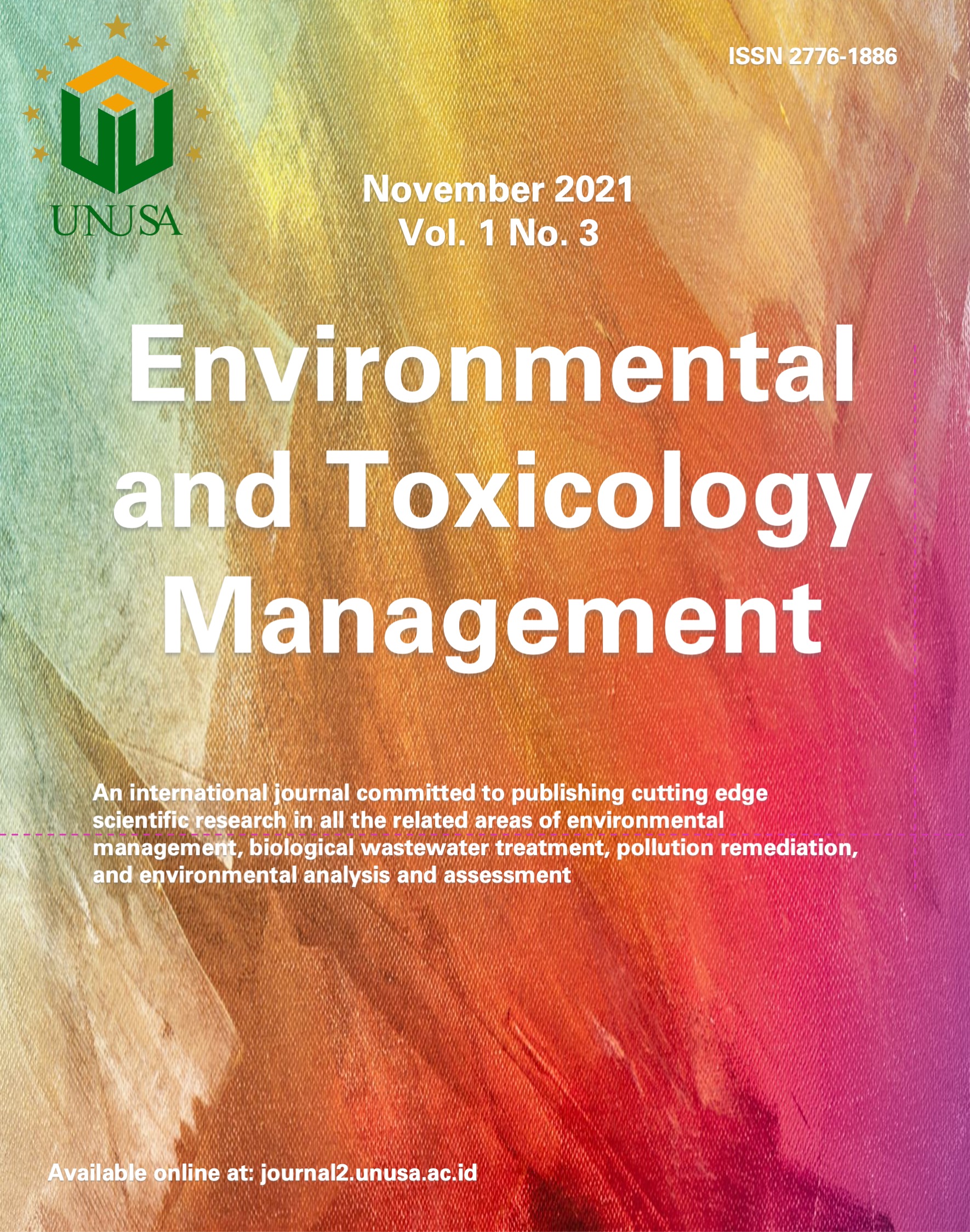Effect of metal content from sewage sludge on the growth of Orthosiphon stamineus
##plugins.themes.bootstrap3.article.main##
Abstract
Municipal sewage sludge can be used as fertilizer as it contains a lot of nutrients. By focusing on copper (Cu), iron (Fe), manganese (Mn), and zinc (Zn) contents in municipal sewage sludge from primary oxidation ponds and in plant tissue sections, this study attempts to explain the relationship between plant yield and metal concentrations. Raw sludge samples were collected, air-dried, and ground to powder form at the beginning of fieldwork. The metal concentrations of sewage sludge were copper 6.9 mg/kg; iron 330.2 mg/kg manganese 6.7 mg/kg and zinc 9.1 mg/kg. Orthosiphon stamineus (cat’s whiskers) was selected and the plant received a different quantity of sludge application ranging from 1 g to 4 g per plant weekly for six consecutive weeks while observations were done for eleven weeks. Physical parameters such as shrub width and height were monitored to determine plant growth. Through this study, the determined optimum sewage sludge dosage for cats’ whiskers was between 2 to 3 g per plant.
Downloads
##plugins.themes.bootstrap3.article.details##
Copyright (c) 2021 Nur Syamimi Zaidi, Johan Sohaili, Zhang Zhan Loh, Azmi Arisa, Norelyza Hussein

This work is licensed under a Creative Commons Attribution-ShareAlike 4.0 International License.
References
Akter, A., Shahjahan, M., Kabir, K., Chowdhury, A., Amin, M. R., Sayem, A. M. S. and Shihab, A. Y., 2017. Effect of Phosphorus and Zinc on Growth, Flowering and Yield of Gladiolus. J. Exp. Agric. Int. 17, 1-11
Asati, A., Pichhode, M. and Nikhil, K., 2016. Effect of heavy metals on plants: an overview. Int. j. appl. innov. eng. manag.
Bose, S. and Bhattacharyya, A. K., 2008. Heavy metal accumulation in wheat plant grown in soil amended with industrial sludge. Chemosphere. 70, 1264-1272
Casado-Vela, J., Sellés, S., Díaz-Crespo, C., Navarro-Pedreño, J., Mataix-Beneyto, J. and Gómez, I., 2007. Effect of composted sewage sludge application to soil on sweet pepper crop (Capsicum annuum var. annuum) grown under two exploitation regimes. Waste Manage. 27, 1509-1518
Chandra, R., Bharagava, R. N., Yadav, S. and Mohan, D., 2009. Accumulation and distribution of toxic metals in wheat (Triticum aestivum L.) and Indian mustard (Brassica campestris L.) irrigated with distillery and tannery effluents. J. Hazard. Mater. 162, 1514-1521
Chen, W., Chang, A. C., Wu, L. and Zhang, Y., 2008. Metal uptake by corn grown on media treated with particle-size fractionated biosolids. Sci. Total Environ. 392, 166-173
Eisler, R., 2000. Handbook of chemical risk assessment: health hazards to humans, plants, and animals, three volume set. New York: Lewis Publisher
Epstein, E., 2002. Land application of sewage sludge and biosolids. USA: CRC Press
Fahad, S., Masoud Ahmad, K., Akbar Anjum, M. and Hussain, S., 2014. The effect of micronutrients (B, Zn and Fe) foliar application on the growth, flowering and corm production of Gladiolus (Gladiolus grandiflorus L.) in calcareous soils. J. Agric. Sci. Technol. 16, 1671-1682
Fernandes, S. A. P., Bettiol, W. and Cerri, C. C., 2005. Effect of sewage sludge on microbial biomass, basal respiration, metabolic quotient and soil enzymatic activity. Appl. Soil Ecol. 30, 65-77
Nayek, S., Gupta, S. and Saha, R. N., 2010. Metal accumulation and its effects in relation to biochemical response of vegetables irrigated with metal contaminated water and wastewater. J. Hazard. Mater. 178, 588-595
Ojuederie, O. B. and Babalola, O. O., 2017. Microbial and Plant-Assisted Bioremediation of Heavy Metal Polluted Environments: A Review. Int J. Environ Res Public Health. 14, 1504
Pandey, S. N., 2018. Biomolecular Functions of Micronutrients Toward Abiotic Stress Tolerance in Plants. Singapore: Springer Singapore
Pavlíková, D., Pavlík, M., Száková, J., Vasickova, S., Tlustos, P. and Balík, J., 2002. The effect of Cd and Zn contents in plants on Fe binding into organic substances of spinach biomass. Rostl. výroba. 48, 531-535
Prasad, M. N. V., Sajwan, K. S. and Naidu, R., 2005. Trace elements in the environment: biogeochemistry, biotechnology, and bioremediation. CRC Press
Rout, G. R. and Sahoo, S., 2015. Role of iron in plant growth and metabolism. Rev. Agric. Sci. 3, 1-24
Sharma, C. P., 2006. Plant micronutrients. Boca Raton: CRC Press
Shenker, M., Plessner, O. E. and Tel-Or, E., 2004. Manganese nutrition effects on tomato growth, chlorophyll concentration, and superoxide dismutase activity. J. Plant Physiol. 161, 197-202
Singh, R. P. and Agrawal, M., 2010. Effect of different sewage sludge applications on growth and yield of Vigna radiata L. field crop: Metal uptake by plant. Ecol. Eng. 36, 969-972
Smith, S. R., 2009. A critical review of the bioavailability and impacts of heavy metals in municipal solid waste composts compared to sewage sludge. Environ. Int. 35, 142-156
Sohaili, J., Zaidi, N. S. and Loon, S. C., 2012. Nutrients content of sewage sludge and its ultilization towards horticulture plant. J. emerg. trends eng technol. 3, 81-85
Stoffella, P. J. and Kahn, B. A., 2001. Compost utilization in horticultural cropping systems. New York: Lewis Publisher
Thapa, S., Bhandari, A., Ghimire, R., Xue, Q., Kidwaro, F., Ghatrehsamani, S., Maharjan, B. and Goodwin, M., 2021. Managing Micronutrients for Improving Soil Fertility, Health, and Soybean Yield. Sustainability. 13, 11766
Warman, P. R. and Termeer, W. C., 2005. Evaluation of sewage sludge, septic waste and sludge compost applications to corn and forage: Ca, Mg, S, Fe, Mn, Cu, Zn and B content of crops and soils. Bioresour. Technol. 96, 1029-1038
Yang, S., Deng, H. and Li, M., 2008. Manganese uptake and accumulation in a woody hyperaccumulator, Schima superba. Plant Soil Environ. 54, 441-446





